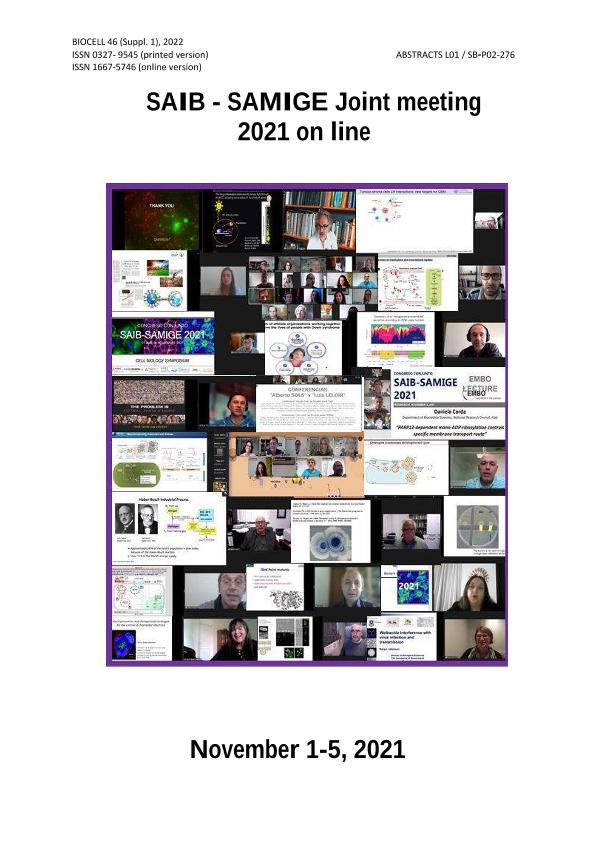Mostrar el registro sencillo del ítem
dc.contributor.author
Lencina, María Fernanda

dc.contributor.author
Farias, Maria Eugenia

dc.contributor.author
Belfiore, Carolina

dc.date.available
2023-06-23T20:11:11Z
dc.date.issued
2022
dc.identifier.citation
Extremophile cyanobacteria: in vitro production of protective compounds against UVB radiation; LVII Annual Meeting of the Argentine Society for Biochemistry and Molecular Biology Research; XVI Annual Meeting of the Argentinean Society for General Microbiology; Ciudad Autónoma de Buenos Aries; Argentina; 2021; 178-178
dc.identifier.issn
1667-5746
dc.identifier.uri
http://hdl.handle.net/11336/201382
dc.description.abstract
The Andean Altiplano-Puna is a sedimentary volcanic plateau at an average altitude of 4000 m located between latitudes 13°and 27° south. Solar irradiance is 165% higher than that at the level of the sea with instant flow of UV-B that reaches 17 Wm2,low nutrient concentration particularly phosphorous; presence of heavy metals and arsenic and broad fluctuation of thetemperature of the air, ranging from 20 °C during the day to -10 ° C at night. Even though these conditions are highly limiting,previous results from our laboratory have described the microbial diversity of different lakes, mats and crust of the altiplanoand revealed an unexpectedly diverse microbial community, including several genera of cyanobacteria. Cyanobacteria isolatedfrom extreme conditions like Andean microbial mats and crust could produce mycosporine-like amino acids (MAAs) as amitigation strategy to reduce the damaging effect of ultraviolet radiation. In order to probe the production of MAAs from thesecyanobacteria, the analysis of the methanolic extract by spectrophotometry was used as a rapid method to know the presenceor absence of these compounds. Different strains of cyanobacteria were placed in quartz tubes and exposed to UVB radiationfor 4 and 24 hours. Then the culture was centrifuged at 10000 rpm during 10 min, and 0,15 g of biomass were placed in tubeswith 15 ml of methanol during 24 h in dark. Methanolic extract was analyzed in a spectrophotometer by scanning from 250nm to 750 nm. Also, the methanolic extract was analyzed with high performance liquid chromatographic (HPLC), using WatersAlliance 2695e - Waters PDA 2998 Detector - Empower 2 Software, Column: Gemini C18-5u-4.6 x 250 mm and the mobilephase: 0.1% acetic acid in methanol 2.5%. The cyanobacteria that showed presence of MAAs were cultivated in differentconditions in order to determine the most convenient: condition 1: light 24 h, without shaking and room temperature; condition2: light:dark 12:12 h, without shaking and 28°C; condition 3: light:dark 12:12 h, without shaking but bubbling air into thereactor and 28° C. The strain GTAR 001, Anabaena sp., showed the most significant peak of absorbance at 334 nm when wasexposed for 24 h to UVB. The MAAs reported for cyanobacteria have peaks between 310 and 360 nm and the peak of 334 nmcorresponds to Shinorine. On the other hand, the strain GTAR 001 produced significantly more biomass with condition 3 andin a shorter period. These preliminary results agree with the MAAs reported for Anabaena sp. isolated from rice paddy fieldand hyper saline pond/marine habitat. It will be necessary to analyze this compound with liquid chromatography coupled withtandem mass spectrometry for the final determination.
dc.format
application/pdf
dc.language.iso
eng
dc.publisher
Tech Science Press

dc.rights
info:eu-repo/semantics/openAccess
dc.rights.uri
https://creativecommons.org/licenses/by/2.5/ar/
dc.subject
UVB RADIATION
dc.subject
CYANOBACTERIA
dc.subject
ANDEAN ALTIPLANO-PUNA
dc.subject.classification
Biotecnología Medioambiental

dc.subject.classification
Biotecnología del Medio Ambiente

dc.subject.classification
INGENIERÍAS Y TECNOLOGÍAS

dc.title
Extremophile cyanobacteria: in vitro production of protective compounds against UVB radiation
dc.type
info:eu-repo/semantics/publishedVersion
dc.type
info:eu-repo/semantics/conferenceObject
dc.type
info:ar-repo/semantics/documento de conferencia
dc.date.updated
2023-06-21T15:47:17Z
dc.journal.volume
46
dc.journal.number
Suppl. 1
dc.journal.pagination
178-178
dc.journal.pais
Estados Unidos

dc.description.fil
Fil: Lencina, María Fernanda. Consejo Nacional de Investigaciones Científicas y Técnicas. Centro Científico Tecnológico Conicet - Tucumán. Planta Piloto de Procesos Industriales Microbiológicos; Argentina
dc.description.fil
Fil: Farias, Maria Eugenia. Consejo Nacional de Investigaciones Científicas y Técnicas. Centro Científico Tecnológico Conicet - Tucumán. Planta Piloto de Procesos Industriales Microbiológicos; Argentina
dc.description.fil
Fil: Belfiore, Carolina. Consejo Nacional de Investigaciones Científicas y Técnicas. Centro Científico Tecnológico Conicet - Tucumán. Planta Piloto de Procesos Industriales Microbiológicos; Argentina
dc.relation.alternativeid
info:eu-repo/semantics/altIdentifier/url/https://techscience.com/biocell/v46nSuppl.1/46213/pdf
dc.conicet.rol
Autor

dc.conicet.rol
Autor

dc.conicet.rol
Autor

dc.coverage
Nacional
dc.type.subtype
Reunión
dc.description.nombreEvento
LVII Annual Meeting of the Argentine Society for Biochemistry and Molecular Biology Research; XVI Annual Meeting of the Argentinean Society for General Microbiology
dc.date.evento
2021-11-01
dc.description.ciudadEvento
Ciudad Autónoma de Buenos Aries
dc.description.paisEvento
Argentina

dc.type.publicacion
Journal
dc.description.institucionOrganizadora
Asociación Civil de Microbiología General
dc.description.institucionOrganizadora
Sociedad Argentina de Investigación en Bioquímica y Biología Molecular
dc.source.revista
Biocell

dc.date.eventoHasta
2021-11-05
dc.type
Reunión
Archivos asociados
